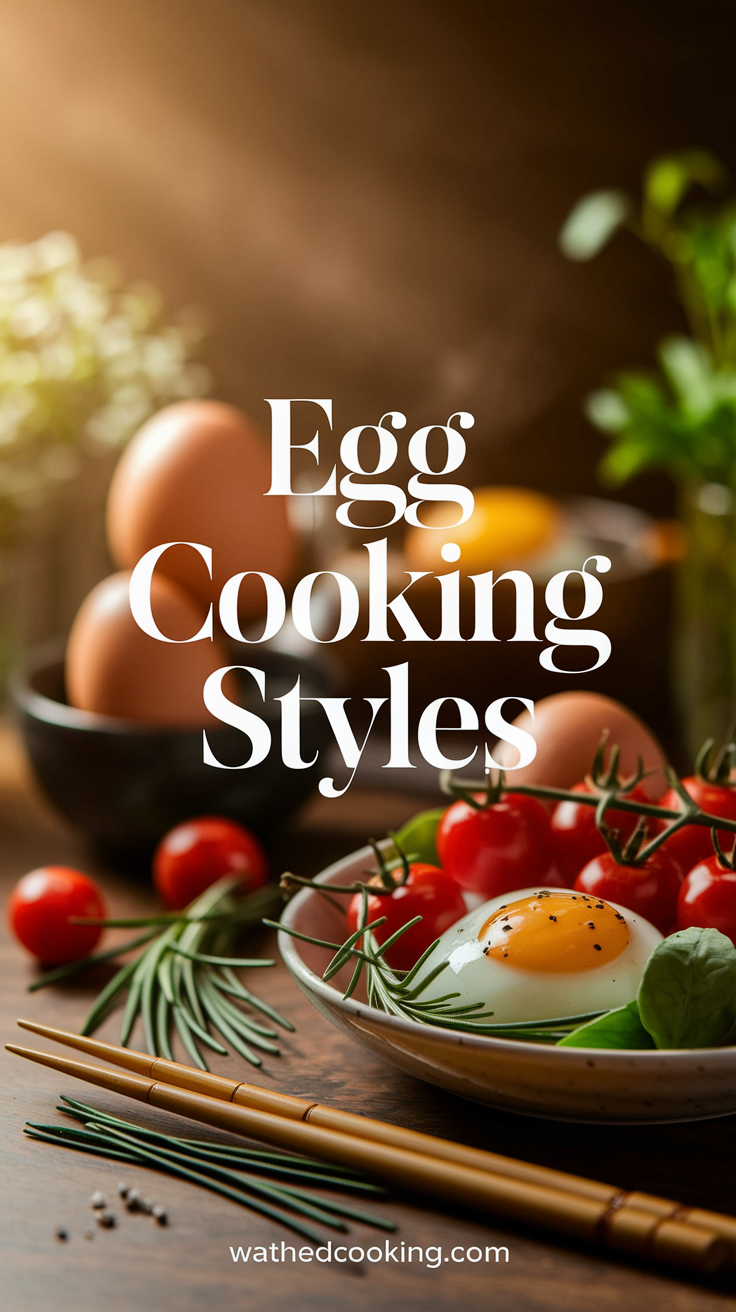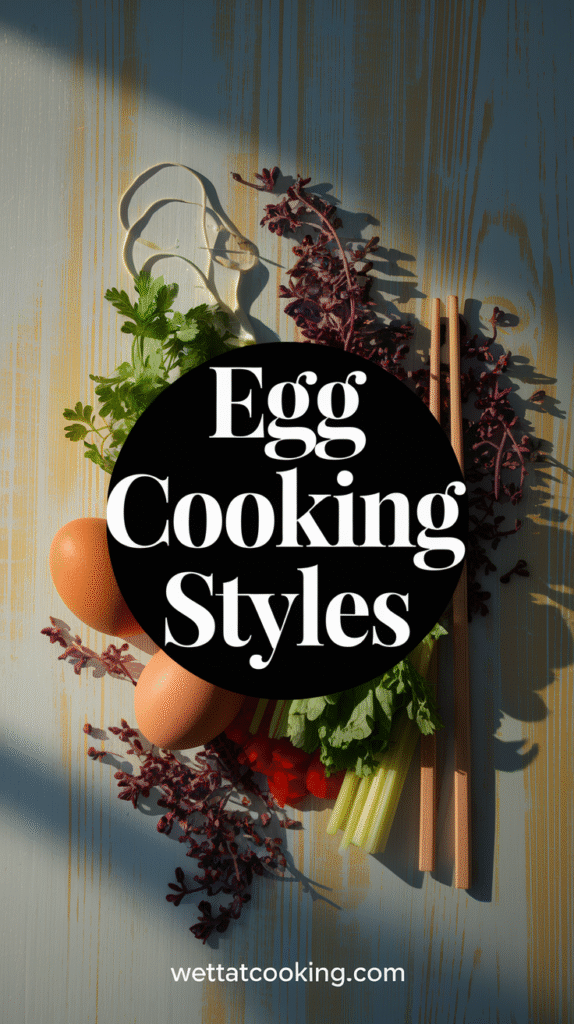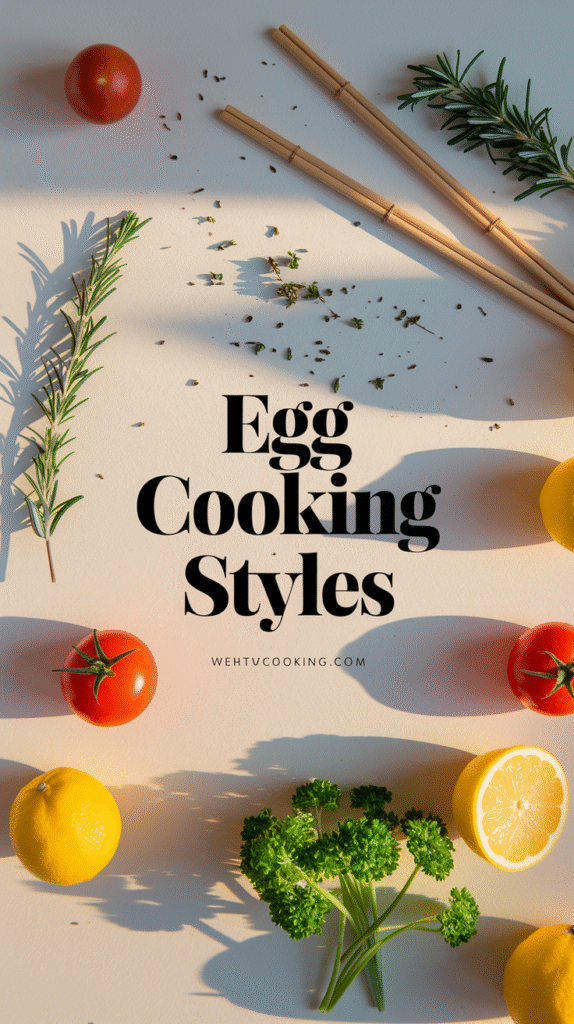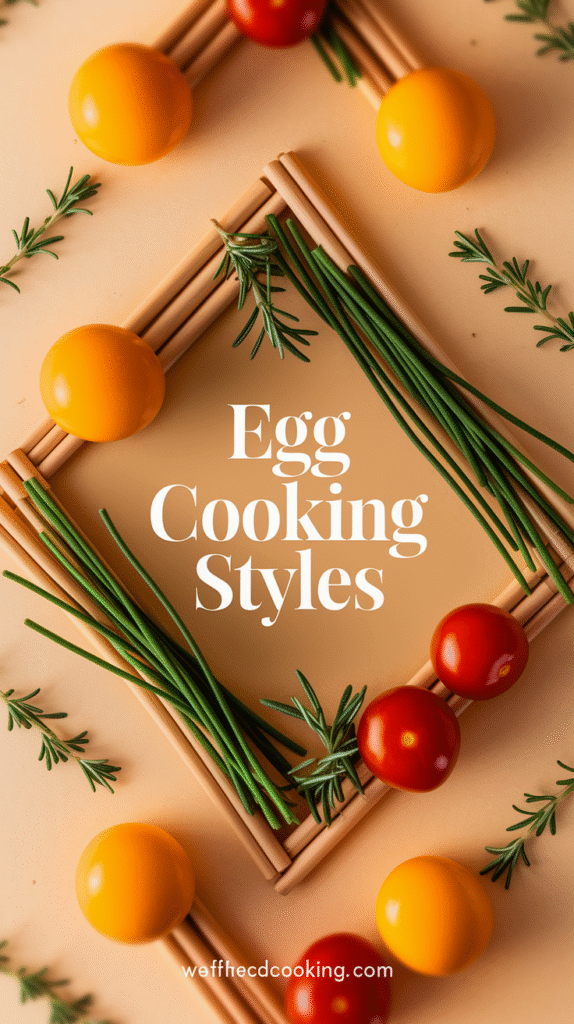Eggs are a versatile ingredient enjoyed worldwide, and their cooking styles vary widely. Each method offers a unique texture and flavor, allowing for endless culinary creativity. Here’s a look at some popular egg cooking styles that can enhance your dishes.
Poached Eggs
Poached eggs are cooked without the shell, gently simmered in water. This method creates a tender egg with a silky yolk. To poach an egg, bring water to a gentle simmer and add a splash of vinegar to help the egg whites coagulate. Crack the egg into a small bowl and gently slip it into the water. Cook for about three to four minutes for a perfect runny yolk.
Key Features of Poached Eggs
- Light and delicate flavor
- Nutritious, with no added fat
- Perfect for salads, toast, or on top of a dish like Eggs Benedict
Scrambled Eggs
Scrambling eggs is a quick and easy method that results in soft and creamy curds. Start by cracking eggs into a bowl and whisk them together with salt and pepper. Heat a non-stick pan over medium-low heat, add a bit of butter, then pour in the eggs. Stir gently with a spatula until they are just cooked but still slightly runny for the best texture.
Tips for Creamy Scrambled Eggs
- Use low heat to avoid rubbery eggs.
- Add a splash of milk or cream for extra creaminess.
- Stir frequently to create soft curds.
Fried Eggs
Fried eggs can be cooked sunny-side-up or over-easy. To fry an egg, heat oil or butter in a skillet. Crack the egg directly into the pan. For sunny-side-up, cook until the white is set but the yolk is still runny. For over-easy, carefully flip the egg and cook it for a minute more until the yolk is slightly firmer.
Why People Love Fried Eggs
- Quick to cook, making them a breakfast staple.
- Variety in preparation (over medium, over hard, etc.).
- Great as a protein-rich topping for burgers or on toast.
Baked Eggs
Baking eggs is a fantastic way to create a one-dish meal. You can crack eggs into a baking dish, add ingredients like cheese, vegetables, or meats, and bake until the eggs are set. This cooking method infuses the eggs with flavors from the other ingredients, making for a delicious brunch option.
Unique Ingredients to Add
- Spinach and feta cheese
- Tomatoes and herbs
- Chorizo and peppers
Omelettes
An omelette is a dish that involves whisking eggs and cooking them in a skillet while folding in various fillings. Classic ingredients include cheese, ham, bell peppers, and mushrooms. The key to a perfect omelette is to keep the heat low, allowing the eggs to cook evenly without browning.
Steps for a Fluffy Omelette
- Whisk eggs with salt and pepper.
- Heat pan and add a small amount of butter.
- Pour in eggs and gently lift edges as they set, tilting the pan to allow uncooked eggs to flow to the edges.
- Add fillings before folding in half and serve immediately.
Egg Cooking Styles in a Table
| Cooking Style | Texture | Time | Best Served With |
|---|---|---|---|
| Poached | Soft, silky | 3-4 minutes | Salads, toast |
| Scrambled | Creamy, soft | 5 minutes | On toast, with veggies |
| Fried | Crisp edges, runny yolk | 3-5 minutes | Sandwiches, burgers |
| Baked | Firm, flavorful | 15-20 minutes | As a main dish |
| Omelettes | Soft, folded | 5-7 minutes | Breakfast or brunch plates |
Exploring these egg cooking styles not only enhances your culinary skills but also enriches your meals. From the breakfast table to sophisticated brunches, eggs can adapt to any occasion. For more techniques and recipes, check out Eggland’s Best or Serious Eats to dive deeper into the world of eggs.
How Cooking Techniques Affect Egg Flavor and Texture
Eggs are a beloved ingredient found in various cuisines worldwide. The magic of eggs lies not only in their versatility but also in how different cooking techniques can dramatically impact their flavor and texture. Understanding these cooking styles will enhance your culinary skills and broaden your culinary repertoire.
Basic cooking techniques for eggs include boiling, frying, poaching, baking, and scrambling. Each method brings out distinct qualities in eggs, making them suitable for various dishes and preferences.
Boiling Eggs
Boiling eggs can produce a range of textures, from soft to hard. The cooking time is crucial for achieving the desired result. Here’s how boiling affects eggs:
- Soft-boiled: Cooked for about 4-6 minutes, resulting in a runny yolk and tender whites.
- Hard-boiled: Requires boiling for 9-12 minutes, producing a firm yolk and fully cooked whites.
The flavor remains mild, but the texture and doneness greatly affect enjoyment. Overcooking can lead to a sulfuric taste, so precision is essential.
Fried Eggs
Frying adds a crispy texture to eggs while enriching their flavor. Here are two popular frying methods:
- Sunny-side up: The egg is cooked on one side until the whites are set and the yolk remains runny. This method keeps the yolk rich and flavorful.
- Over-easy: Similar to sunny-side up but flipped briefly to cook the top. The yolk is still runny, but the whites are fully cooked.
Fried eggs often develop a delicious, buttery flavor, especially when cooked in oil or butter. The texture can be crispy or soft, depending on the cooking time.
Poached Eggs
Poaching eggs results in a tender and delicate product without added fat. The egg is gently submerged in simmering water, allowing it to cook slowly. The result is a soft white enveloping a creamy yolk. Poached eggs are often used in dishes like Eggs Benedict, showcasing their ability to combine flavors elegantly.
Baked Eggs
Baking eggs introduces unique textures and blends flavors beautifully. Common methods include:
- Shakshuka: Eggs are poached in a spicy tomato sauce, allowing the flavors to mingle.
- Egg casserole: Whisked eggs are combined with vegetables, cheeses, and meats, then baked to create a fluffy, flavorful dish.
The baking process brings out different flavor profiles as the eggs absorb surrounding ingredients. The result is often rich and satisfying.
Scrambled Eggs
Scrambled eggs are a breakfast favorite that can be creamy or fluffy, depending on the technique. Here’s how cooking methods influence their characteristics:
- Classic Scrambled: Whisked eggs cooked quickly in a pan often yield soft, creamy results when stirred continuously.
- Slow-Cooked Scrambled: Cooking at a low temperature allows for gentle curd formation, resulting in dense, custardy eggs.
The flavor in scrambled eggs can be intensified by adding herbs, cheese, or spices during cooking.
Comparative Flavor and Texture Table
| Cooking Method | Flavor Profile | Texture |
|---|---|---|
| Boiled | Mild, slightly sulfuric if overcooked | Firm (hard) or runny (soft) |
| Fried | Rich, buttery | Crispy edges, soft interior |
| Poached | Delicate, clean | Tender whites, runny yolk |
| Baked | Rich, varied based on other ingredients | Fluffy, combined with other textures |
| Scrambled | Variable; can be creamy or fluffy | Soft, curds based on cooking speed |
Experimenting with different cooking styles can elevate your egg dishes and indulge your palate. If you’re interested in more egg recipes and techniques, check out resources like Eggs Canada and America’s Test Kitchen.
Understanding how cooking methods affect flavor and texture allows you to tailor egg dishes to your liking. Whether you prefer soft-boiled eggs on toast, a creamy scrambled delight, or a rich frittata, mastering these techniques can transform your dining experience. So, roll up your sleeves and get cracking!
The Nutritional Benefits of Various Egg Cooking Methods
Eggs are a powerhouse of nutrition, and how you cook them can significantly affect their health benefits. Different egg cooking styles can enhance or reduce the nutritional profile of this versatile food. Here’s an exploration of various egg cooking methods and their nutritional benefits.
Boiled Eggs
Boiling is one of the most common methods for cooking eggs, and it preserves a high percentage of nutrients. Boiled eggs can be prepared as:
- Hard-boiled: Cooked in water until the yolk is fully set. They are rich in protein, B vitamins, and healthy fats.
- Soft-boiled: Cooked until the whites are firm, but the yolk remains runny. This method retains more antioxidants and retains more vitamin A than hard-boiled eggs.
Both types of boiled eggs contain essential amino acids that are vital for muscle repair and growth.
Poached Eggs
Poaching involves cooking eggs in water or broth without their shell. This method is low in fat since you don’t need any oil or butter. Poached eggs are an excellent source of quality protein and maintain their nutrients effectively. They are also easier to digest compared to fried eggs, making them a great option for those with digestive issues.
Scrambled Eggs
Scrambled eggs can be both nutrient-dense and delicious. When cooked with minimal additives like butter or milk, they provide a wholesome meal:
- Lightly Scrambled: Retain more protein and vitamins than those cooked for longer periods. The key is to cook them gently and not let them dry out.
- Cheesy Scrambled: Adding cheese increases calcium but also includes extra fat and calories. Use sparingly for maximum benefit.
The mix of ingredients can influence both taste and nutrition, so choose wisely!
Fried Eggs
Fried eggs, often cooked in oil or butter, are delicious but can add extra calories and fats. To keep them on the healthier side, consider:
- Sunnyside Up: The yolk remains raw, preserving nutrients. However, it’s crucial to use a healthy oil, such as olive oil, which provides monounsaturated fats.
- Over Easy: These allow the yolk to be slightly cooked, enhancing its flavor, but still, full of nutrients. The key is cooking them briefly to minimize nutrient loss.
Fried eggs are a solid source of vitamin D, but moderation and healthier cooking methods should be prioritized.
Omelets
Omelets are versatile and can incorporate various ingredients such as vegetables, cheese, or meats. The addition of vegetables boosts their vitamin and mineral content significantly. Here are some tips to make a healthier omelet:
- Use fresh vegetables like spinach, tomatoes, and bell peppers for added fiber.
- Consider using egg whites or a combination of whole eggs and egg whites to reduce fat and cholesterol intake.
With these modifications, omelets can provide a balanced meal rich in protein, fiber, and other vital nutrients.
Egg Nutrition Summary
| Cooking Method | Protein (g) | Calories | Fat (g) |
|---|---|---|---|
| Hard-Boiled | 6.3 | 68 | 4.8 |
| Soft-Boiled | 6.3 | 68 | 4.8 |
| Poached | 6.3 | 70 | 4.8 |
| Scrambled | 6.4 | 90 | 7.0 |
| Fried | 6.6 | 90 | 7.0 |
| Omelet | 6.5 | 94 | 7.0 |
By exploring these different egg cooking styles, you can enhance your meals’ nutritional value while enjoying a variety of flavors and textures. For more information about egg recipes and cooking methods, you can visit Egg Bite or Egg Nutrition Center.
Experimenting with different cooking styles can lead to discovering what you enjoy most while maximizing the health benefits that eggs offer. Remember, the right cooking method can elevate not just the taste but also the nutritional impact of your meals!
Creative Egg Cooking Styles for Breakfast and Beyond
Eggs are a breakfast staple around the world, and their versatility makes them perfect for any meal. If you’re looking to spice up your cooking routine, exploring different egg cooking styles can provide delightful flavors and textures. Whether you’re a novice cook or a culinary enthusiast, discovering creative methods to prepare eggs will keep every meal exciting.
Classic Cooking Styles
Understanding traditional cooking styles can lay the foundation for mastering eggs. Here are some classic methods:
- Scrambled: Whisk eggs with a splash of milk or cream, then cook them over medium heat until they’re fluffy. Stir gently for soft curds.
- Fried: Use a skillet to fry eggs sunny-side up, over-easy, or hard. Adjust cooking time for your preferred doneness.
- Boiled: Boil eggs in water; soft-boiled eggs are tender with a runny yolk, while hard-boiled eggs are fully cooked throughout. Aim for 6-7 minutes for soft-boiled and 9-12 minutes for hard-boiled.
Innovative Cooking Techniques
Once you feel comfortable with these basics, consider trying some innovative egg cooking styles to impress your family and friends:
- Baked Eggs: Crack eggs into a baking dish and add vegetables, cheese, or meats. Bake until set for a hearty dish called Shakshuka.
- Poached: Simmer eggs gently in water, creating delicate eggs perfect for dishes like Eggs Benedict. You’ll need a little practice to achieve that perfect poach.
- Omelettes: Fill beaten eggs with your choice of cheese, meats, and veggies before folding them. Try variations like Spanish tortillas for an innovative twist.
International Egg Dishes
Diving into global cuisine can offer fresh inspiration. Here are some delightful egg dishes from around the world:
| Dish | Origin | Description |
|---|---|---|
| Cloud Eggs | France | Creamy eggs whipped into a cloud-like foam, baked and topped with the yolk. |
| Tamago Sushi | Japan | Sweet, layered omelet served over sushi rice, often shaped in a rectangular mold. |
| Spanish Tortilla | Spain | A thick omelet loaded with potatoes and onions, perfect for any meal. |
| Migas | Mexico | Eggs scrambled with tortilla strips, topped with salsa for a satisfying breakfast. |
Creative Egg Breakfast Ideas
Now let’s take the egg experience a step further. Here are some creative ideas to elevate your breakfast:
- Egg Muffins: Whisk eggs with your choice of fillings and pour them into muffin tins. Bake for a convenient, portable breakfast.
- Egg and Avocado Toast: Top whole-grain toast with smashed avocado and a poached egg for a deliciously trendy dish.
- Breakfast Burrito: Wrap scrambled eggs with veggies, cheese, and salsa in a tortilla for a filling breakfast on the go.
- Shakshuka: Place eggs in a spicy tomato sauce with bell peppers, perfect for dipping crusty bread.
Experimenting with different egg cooking styles not only enhances your culinary skills but also transforms mundane meals into exciting ones. Whether you choose to keep it simple or go the gourmet route, the possibilities are nearly endless.
To explore more egg recipes and cooking techniques, visit the Egg Farmers of Canada or check out Food Network’s Egg Recipes for a variety of ideas and inspiration.
Common Mistakes to Avoid When Cooking Eggs
Cooking eggs is an art that can easily turn into a science. There are numerous egg cooking styles, from boiling to poaching and scrambling to frying. Each method has its unique charm, but even the most experienced cook can make mistakes. Here are some common pitfalls to avoid when cooking eggs to ensure that your dish is always perfect.
Using the Wrong Egg Type
Not all eggs are created equal. When selecting eggs for different cooking styles, consider their size and freshness. Fresh eggs are ideal for poaching and frying, while older eggs are better for hard boiling. For scrambled eggs, choose large, farm-fresh eggs for the best taste and texture.
Inconsistent Cooking Temperature
One significant mistake is cooking eggs over inconsistent heat. Maintain a steady, moderate temperature when cooking eggs to prevent them from becoming rubbery or overcooked. For scrambled eggs, low heat allows for slow cooking, ensuring a creamy consistency. When frying, you should see gentle sizzling without aggressive bubbling.
Overcooking Eggs
Overcooking is one of the most common mistakes when making eggs. Whether you’re boiling, frying, or scrambling, overcooked eggs can lose their creamy texture and delightful flavor. Keep the following tips in mind:
- Boiling: For hard-boiled eggs, place them in cold water, bring to a boil, then turn off the heat and cover for 9-12 minutes, depending on desired firmness.
- Frying: Cook eggs sunny side up or over-easy for just a few minutes to maintain the runny yolk.
- Scrambling: Stir gently and remove from heat when the eggs are still slightly runny, as they will continue to cook off the heat.
Not Seasoning Properly
It may seem simple, but seasoning is essential. Many forget to season their eggs until after cooking, which can lead to blandness. A pinch of salt and pepper during cooking enhances flavor. For more zest, consider adding herbs or spices such as chives or paprika.
Forgetting to Prepare the Pan
The cooking surface is just as important as the egg itself. For frying or scrambling, always preheat and grease your pan adequately. Use non-stick cookware or a well-seasoned cast iron skillet to avoid sticking. This ensures that your eggs come out intact and beautifully presented. Lubricating your pan before the cooking process is key to achieving that perfect dish.
Ignoring Freshness
Freshness can make or break your egg dish. Conduct a freshness test by placing your egg in a bowl of water. If it sinks, it’s fresh; if it stands upright or floats, it’s time to let it go. Fresh eggs result in better flavor, texture, and overall appearance.
Rushing the Cooking Process
Eggs require your patience. Allow them the time they need to cook properly. Rushing might leave you with a compromised dish. Make sure to give each cooking style the right amount of time. Enjoy the process and savor the results! For instance, perfect scrambled eggs take just a few minutes longer than the rushed ones, but the texture difference is significant.
Using the Wrong Tools
The right tools can elevate your egg cooking experience. Here’s a quick list of helpful essentials:
- Spatula: Opt for a silicone or wooden spatula to avoid scratching non-stick pans.
- Whisk: For scrambled eggs, a whisk ensures uniform mixing.
- Timer: Helps in achieving the perfect cooking time for various egg styles.
Not Experimenting with Flavor
Eggs are incredibly versatile and can take on various flavors. Don’t hesitate to experiment with different herbs, cheeses, or sauces. From classic combinations to adventurous twists, your taste buds will thank you for it. Try adding some cheese while scrambling or topping poached eggs with hollandaise sauce for a delightful breakfast.
Avoiding these common mistakes when cooking eggs can lead to more delicious and visually appealing dishes. Investing the time to learn the intricacies of each cooking style will ensure that every egg dish you prepare is a winner. For more tips on cooking eggs and exploring different methods, check out resources like Food Network or Epicurious.
Conclusion
Egg cooking styles are incredibly diverse, each offering unique flavors, textures, and opportunities for creativity in your meals. From the delicate approach of poaching to the quick and easy method of scrambling, every technique can significantly impact the way eggs taste and feel. Understanding how these cooking methods interact with the egg’s natural characteristics allows you to elevate your dishes to new culinary heights.
Choosing the right cooking style not only enhances flavor but also contributes to a healthier meal. Techniques like steaming and poaching preserve nutrients better than frying, allowing you to enjoy the full benefits of the protein and vitamins eggs provide. Additionally, experimenting with creative styles—such as baking eggs in avocado or creating a savory shakshuka—can keep your breakfast menu exciting and nutritious.
However, achieving the perfect egg isn’t without its challenges. Recognizing common mistakes, such as overcooking or failing to season properly, can make a significant difference in your outcome. With practice and attention to detail, you can refine your skills and master various egg cooking methods.
As you explore the multitude of egg cooking styles, remember that the journey is all about enjoyment and experimentation. Whether you’re crafting a simple meal or a gourmet dish, the versatility of eggs can inspire you to try something new and delicious. The next time you’re in the kitchen, consider how these techniques can transform your eggs into a dish that excites your palate and nourishes your body. Happy cooking!







Leave a Reply